The energy matrix and sustainable development in Latin America
The proposal for an ecological growth model must take into account the structure of the energy sector in Latin American countries.
- Análisis

In August 2019, the Economic Commission for Latin America and the Caribbean (ECLAC) noted that Latin American countries should be concerned about the environment, and not only about economic growth, combating inequality and increasing productivity. The proposal for an ecological growth model must take into account the structure of the energy sector in Latin American countries. The energy sector is of great importance for economic growth because it is one of its driving sources. Thus, when speaking of "sustainable growth", as ECLAC calls it, the ecological origin of the energy used for economic activity must be taken into account.
In Latin America, the ratio of total energy production directed to exports represents more than half for some countries: Ecuador with 70% (crude oil), Venezuela with 66% (crude oil), Bolivia with 65% (natural gas), Trinidad and Tobago with 58% (oil derivatives) and Paraguay with 51% (electricity produced with hydro energy). In general, these exported non-renewable energies are considered to be dirty, because of their high degree of environmental impact and non-renewable character. The extraction of oil and natural gas causes pollution of ecosystems and the emission of greenhouse gases, which contributes to global warming.
The dynamics of dirty energy exports are present throughout Latin America. Crude oil exported by Colombia, Mexico, Guatemala, Honduras and Jamaica, and natural gas, especially Peruvian and Bolivian, are the main sources of energy exported in this region. With the exception of Colombia and Venezuela, oil-exporting countries do not have the productive capacity to refine crude oil. This subjects oil exporters to importing oil derivatives for final consumption.
As for imports, 13 of the 21 Latin American countries reviewed import more than half of their final energy consumption. Most of the imports from these countries are petroleum products for electricity generation or for transport consumption. The second most imported energy source is natural gas to generate electricity or to liquefy it and resell it with greater added value, as in the case of Peru.
Brazil, Bolivia, Colombia, Venezuela and Argentina are the only countries that enjoy energy sovereignty. They produce domestically enough to satisfy their demand, they even have surplus production aimed at exports, and in turn, the percentage of consumption of foreign origin is below 30%. For the most part, Brazilian and Argentine imports correspond to natural gas from Bolivia, for electricity generation, and electricity from Uruguay, according to OEC MIT data. The cases of the Dominican Republic, Jamaica and Panama also stand out due to their percentage of final consumption imports greater than one hundred. This is explained by the fact that in these economies a large part of fuel imports remains on ships for international trade, so that they never become part of domestic consumption.
The main partners per country and their share of imported refined oil in the total of this product have a common denominator in almost all Latin American economies. The predominant partner, in 19 of the 21 countries, is the United States, with which 11 have a free trade agreement. This logic conditions the economic dynamics of the region, due to the concentration of the U.S. oil and refining market, the volatility of the oil price and the fall in productivity in this sector since 2014 with negative annual growth.
Faced with the new boost from ECLAC's green economy, it should be emphasized that 15 Latin American countries consume less than 30% of green energy in relation to the total. These countries use biomass as a source of energy, mainly firewood; through a burning process, electrical or heat energy is obtained. This process, however, is not exempt from emitting greenhouse gases. There are still very few existing green energy projects: like the solar farm in Jujuy, Argentina or wind farms in Oaxaca, Mexico. The structure of production and energy consumption in Latin America remains still predominantly dirty energy.
ECLAC's proposal for sustainable growth cannot ignore the situation of the Latin American energy sector based on exporting oil and natural gas, importing oil derivatives and consuming, for the most part, dirty energy imported from the United States. It is a sector that is dependent on the outside world and not at all ecological. Even electricity generated with hydraulic energy is not necessarily green energy, although it does not emit pollutants, it does affect aquatic ecosystems in the long run.
Initiatives to move towards a sustainable economy such as the issuance of green bonds, or the proposals of COP21, promote the generation of green energy for Latin American countries, but progress is very slow considering the problem is not in the future, but in the present. All indications are that China is accumulating its own solar technology, which is the fastest growing in terms of installed solar energy capacity. In this, it differs from the United States, which is clinging to the export of refined gasoline and gasoline-powered vehicles. Latin America still does not take clean energy seriously, which may arrive from China sooner rather than later.
- Oscar Ugarteche, Senior Researcher IIEc-UNAM, SNI-Conacyt, Coordinator of obela.org
- Carlos de León, Faculty of Economics, member of obela.org
Source: Latin American Economic Observatory (OBELA), Institute of Economic Research, UNAM.
Del mismo autor
- El multilateralismo bipolar 08/03/2022
- Bipolar multilateralism 07/03/2022
- What does 2022 bring? Uncertainty 31/01/2022
- ¿Qué trae el 2022? Incertidumbre 31/01/2022
- The most expensive Christmas of the century... (so far) 20/01/2022
- La navidad más cara del siglo (hasta ahora) 20/01/2022
- Lo que pasó en el 2021 10/01/2022
- What happened in 2021 10/01/2022
- Estados Unidos: el elefante en la habitación 08/11/2021
- The elephant in the room 07/11/2021








